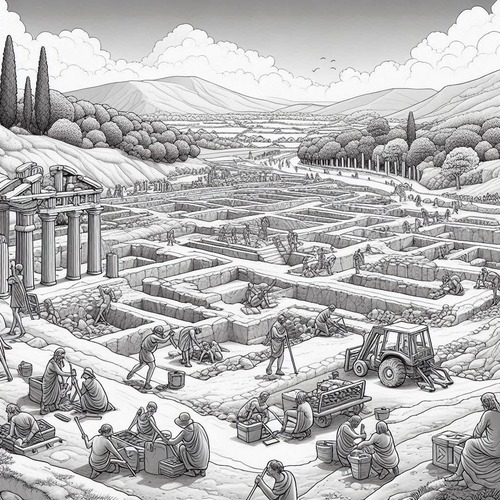Archaeology Endorses Scripture: Papyri and Dead Sea Scrolls
The reliability of the Bible has long been a subject of debate among scholars, historians, and believers. However, two monumental archaeological discoveries—the Dead Sea Scrolls and various ancient papyri, between 1920 and 1956—provide compelling evidence affirming the historical reliability of the Scriptures. These finds have shed light on the textual accuracy, historical context, and authenticity of the biblical manuscripts, reinforcing the faith of believers and intriguing scholars worldwide.
Archaeology Endorses Scripture: The Dead Sea Scrolls
The Dead Sea Scrolls, discovered between 1947 and 1956 in the Qumran Caves near the Dead Sea, represent one of the most significant archaeological finds of the 20th century. These ancient Jewish texts include some of the oldest known manuscripts of the Hebrew Bible, dating from the third century BCE to the first century CE.
- Textual Integrity and Consistency: One of the most compelling aspects of the Dead Sea Scrolls is their contribution to confirming the textual integrity of the Hebrew Bible. Prior to their discovery, the oldest known manuscripts of the Hebrew Bible dated back to the 10th century CE, specifically the Masoretic Text. The Dead Sea Scrolls pushed this timeline back by a millennium, providing manuscripts such as the Isaiah Scroll that are over 2,000 years old.
Comparative analysis between the Dead Sea Scrolls and the Masoretic Text reveals a remarkable consistency. For example, the Great Isaiah Scroll, found among the Dead Sea Scrolls, is almost identical to the Masoretic Text of Isaiah, with only minor variations that do not affect the fundamental meaning of the text. This consistency over such a long period underscores the meticulous care with which Jewish scribes copied the Scriptures, affirming the reliability of the biblical text we have today .
- Historical and Cultural Context: The Dead Sea Scrolls also provide invaluable insights into the historical and cultural context of the Second Temple Judaism era. The scrolls include not only biblical manuscripts but also sectarian writings, hymns, and commentaries, which shed light on the beliefs, practices, and expectations of the Jewish community at Qumran. Understanding these cultural and religious contexts enhances our comprehension of the New Testament, written in a milieu heavily influenced by Jewish thought and practice. This deeper historical understanding supports the coherence and continuity of the biblical narrative .
Archaeology Endorses Scripture: Ancient Papyri
Alongside the Dead Sea Scrolls, the discovery of ancient papyri has significantly bolstered the credibility of the New Testament. Key finds include the Rylands Library Papyrus P52, the Bodmer Papyri, and the Chester Beatty Papyri.
- The Rylands Library Papyrus P52: The Rylands Library Papyrus P52, also known as the St. John’s Fragment, is the oldest known fragment of the New Testament, dating to approximately 125 CE. It was acquired by Bernard Grenfell in Egypt in 1920, but its significance was not recognized until it was published by C.H. Roberts in 1935. The small fragment contains portions of the Gospel of John (John 18:31-33, 37-38), providing concrete evidence that the Gospel of John was in circulation within a generation of the events it describes. The early dating of P52 supports the traditional view that the Gospels were written by eyewitnesses or close associates of eyewitnesses, lending credibility to their accounts .
- The Bodmer Papyri: The Bodmer Papyri, dating from the 2nd to 4th centuries CE, include significant portions of the Gospels of Luke and John, as well as other New Testament writings. They were discovered in Egypt in 1952 and later purchased by Martin Bodmer, a Swiss collector. They were subsequently named after him. These manuscripts help bridge the gap between the original autographs and later copies, demonstrating the textual stability of the New Testament over time. The Bodmer Papyri, like the Dead Sea Scrolls, show a high degree of consistency with later manuscripts, reinforcing the reliability of the New Testament texts we have today.
- The Chester Beatty Papyri: The Chester Beatty Papyri, dating from the 3rd century CE, contain extensive portions of the New Testament, including the Gospels, Acts, and Pauline Epistles. These papyri provide further evidence of the early and widespread dissemination of New Testament writings. The textual consistency found in these manuscripts, when compared with later copies, underscores the care with which early Christians preserved these sacred texts. The Chester Beatty Papyri were found in Egypt in 1930, and were purchased by the American collector Chester Beatty and first published between 1933 and 1936.
Conclusion: Faith and Reason United
The discoveries of the Dead Sea Scrolls and ancient papyri have provided overwhelming evidence supporting the reliability of the biblical texts. These ancient manuscripts demonstrate the remarkable consistency and accuracy with which the Scriptures have been transmitted over the centuries. They also offer rich insights into the historical and cultural contexts of the biblical narratives, enhancing our understanding and appreciation of the Bible.
Believing in the reliability of the Bible is not merely a matter of blind faith; it is a position grounded in solid historical and archaeological evidence. The meticulous preservation and transmission of these texts, alongside their consistency over millennia, attest to their authenticity and authority.
References
- Wise, Michael O., Abegg, Martin G. Jr., and Cook, Edward M. The Dead Sea Scrolls: A New Translation. HarperOne, 2005.
- VanderKam, James C., and Flint, Peter. The Meaning of the Dead Sea Scrolls. HarperOne, 2002.
- Schiffman, Lawrence H. Reclaiming the Dead Sea Scrolls. Yale University Press, 1994.
- Rylands Library Papyrus P52: A Study of the Text and Its Significance.
- The Bodmer Papyri: Early Witnesses to the New Testament Text.
- The Chester Beatty Biblical Papyri: Descriptions and Texts of Twelve Manuscripts on Papyrus of the Greek Bible.
Related Reads:
- Connecting the Dots: How Undesigned Coincidences Confirm Bible Reliability
- Historical Reliability of the Bible: Astonishing Archaeological Finds
- Canonicity: The Journey to the Bible We Know Today
- Unearthing the Past: Excavation Findings that Validate Bible Narratives
- Bible ‘Contradictions’: Hurdles to Faith? Not Quite
Editor's Pick

From Empty to Overflow: The Abundant Life Jesus Promised
(AND WHY YOU SHOULDN’T SETTLE FOR LESS) We're surviving, but are we thriving? If we're honest, there's a gap between [...]

What Does Jesus Save Us From?
THREE BIBLE TRUTHS ABOUT SALVATION "Jesus saves." We’ve seen it on bumper stickers, heard it shouted at sporting events, maybe [...]

If God Wants Everyone Saved, Why Aren’t They?
THE REFORMED VIEW ON GOD’S DESIRE VS HIS DECREE The question haunts every believer who has lost an unbelieving loved [...]

The One Man Mystery in Acts 17:26: Is It Adam Or Noah?
When the Apostle Paul stood before the philosophers at Mars Hill, he delivered an insightful statement about human unity: “And [...]

Megiddo Or Jerusalem: Where Did King Josiah Die?
Recent archaeological discoveries at Tel Megiddo continue to reveal evidence of Egyptian military presence during the late 7th century BC, [...]

Losing Your Life Vs Wasting It: How Are the Two Different?
AND WHY DID JESUS PRAISE THE FORMER? Jesus spoke one of the most perplexing statements in Scripture: “For whoever wants [...]

Can Christians Be Demon Possessed? What the Bible Teaches
Perhaps you’ve witnessed disturbing behavior in a professing Christian, or you’ve struggled with persistent sin and wondered if something darker [...]

Sacred Fury: What Christ’s Temple Cleansing Truly Means
Mark 11 records the crack of a handmade whip that echoed through the temple corridors. Tables crashed to the ground, [...]

Did Jesus Cleanse the Temple Twice?
OR DID JOHN DISAGREE WITH THE SYNOPTICS ON TIMING? One of sceptics’ favourite "gotcha" questions targets what they see as [...]

Self-Authentication: Why Scripture Doesn’t Need External Validation
"How can the Bible prove itself? Isn't that circular reasoning?" This objection echoes through university classrooms, coffee shop discussions, and [...]
SUPPORT US:
Feel the Holy Spirit's gentle nudge to partner with us?
Donate Online:
Account Name: TRUTHS TO DIE FOR FOUNDATION
Account Number: 10243565459
Bank IFSC: IDFB0043391
Bank Name: IDFC FIRST BANK






